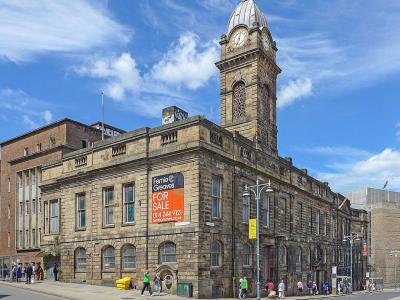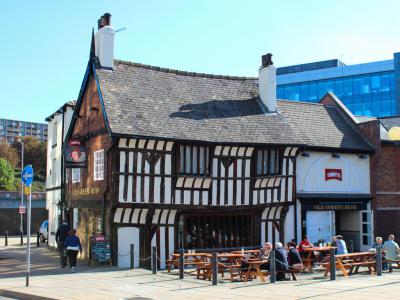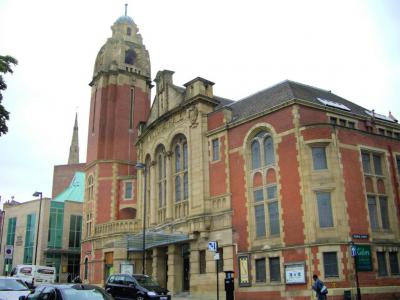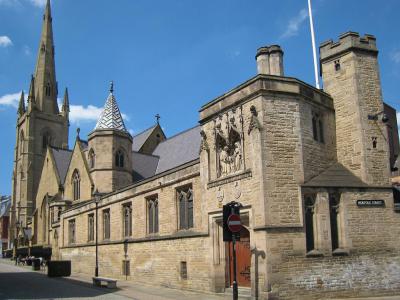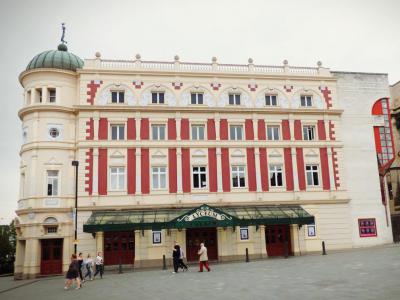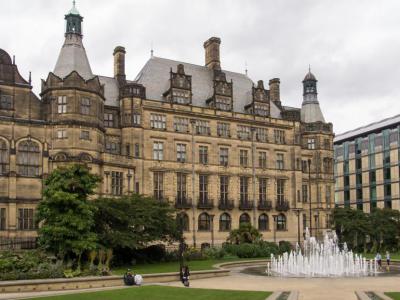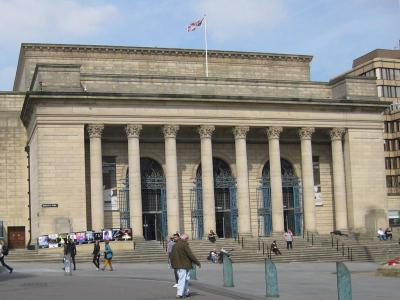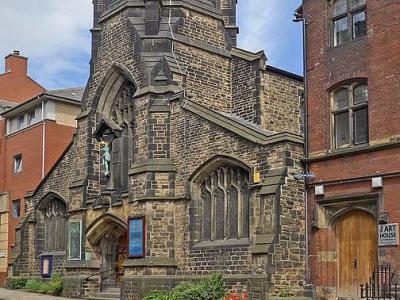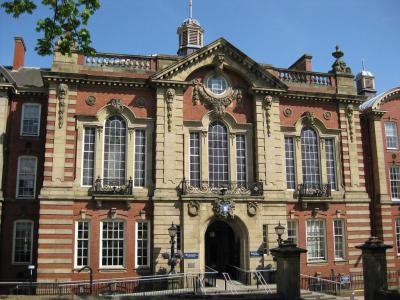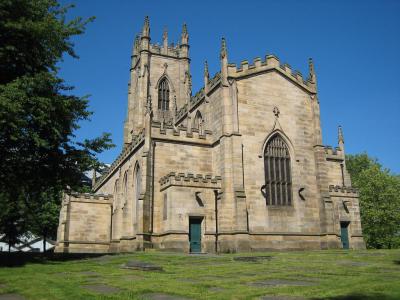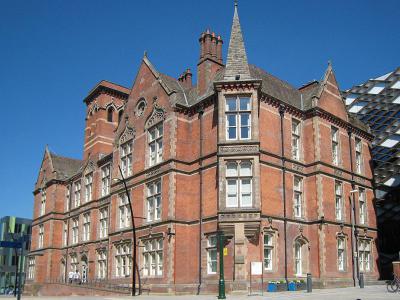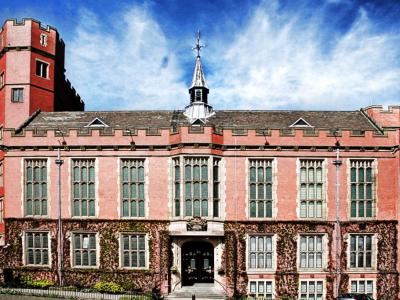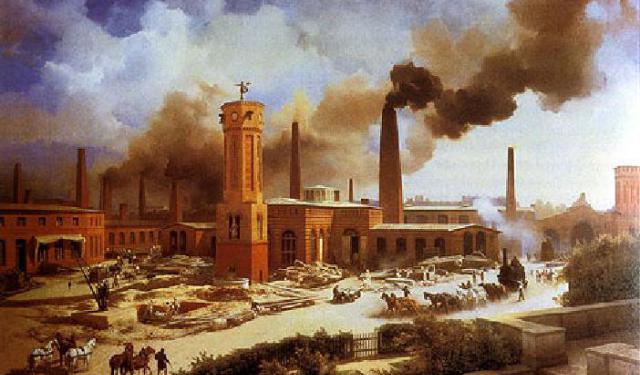Sheffield's Historical Buildings (Self Guided), Sheffield
Part of Sheffield’s great heritage is manifested in buildings. The presence of historical sites, some rather imposing like the Sheffield Town Hall and City Hall, presiding over the area, and the others like the Church of St Marie, somewhat hidden from view in a built-up neighbourhood, provides a colourful illustration of the city's glorious past.
Constructed over a time-span ranging from the 13th to the 20th century, the historical architecture of Sheffield varies in styles dictated by the eras in which it was created – from Tudor, at the turn of the 15th century, to the Edwardian, Classical and Gothic Revival styles in the 18th and 19th centuries.
The majority of Sheffield's older buildings appeared during the Industrial Revolution, when many medieval structures were demolished; others were lost during the Sheffield Blitz in 1940. Luckily, some of the oldest domestic buildings have survived, like the Old Queen's Head pub, opened in 1475.
Sheffield's architectural tapestry harmoniously unites religious sites like Victoria Hall with secular buildings like Lyceum Theatre, and educational institutions like Sir Frederick Mappin Building and Firth Court – parts of the University of Sheffield campus.
If you are interested in exploring more closely the historical buildings of Sheffield, we recommend that you take this self-guided walk.
Constructed over a time-span ranging from the 13th to the 20th century, the historical architecture of Sheffield varies in styles dictated by the eras in which it was created – from Tudor, at the turn of the 15th century, to the Edwardian, Classical and Gothic Revival styles in the 18th and 19th centuries.
The majority of Sheffield's older buildings appeared during the Industrial Revolution, when many medieval structures were demolished; others were lost during the Sheffield Blitz in 1940. Luckily, some of the oldest domestic buildings have survived, like the Old Queen's Head pub, opened in 1475.
Sheffield's architectural tapestry harmoniously unites religious sites like Victoria Hall with secular buildings like Lyceum Theatre, and educational institutions like Sir Frederick Mappin Building and Firth Court – parts of the University of Sheffield campus.
If you are interested in exploring more closely the historical buildings of Sheffield, we recommend that you take this self-guided walk.
How it works: Download the app "GPSmyCity: Walks in 1K+ Cities" from Apple App Store or Google Play Store to your mobile phone or tablet. The app turns your mobile device into a personal tour guide and its built-in GPS navigation functions guide you from one tour stop to next. The app works offline, so no data plan is needed when traveling abroad.
Sheffield's Historical Buildings Map
Guide Name: Sheffield's Historical Buildings
Guide Location: England » Sheffield (See other walking tours in Sheffield)
Guide Type: Self-guided Walking Tour (Sightseeing)
# of Attractions: 12
Tour Duration: 2 Hour(s)
Travel Distance: 2.9 Km or 1.8 Miles
Author: nicole
Sight(s) Featured in This Guide:
Guide Location: England » Sheffield (See other walking tours in Sheffield)
Guide Type: Self-guided Walking Tour (Sightseeing)
# of Attractions: 12
Tour Duration: 2 Hour(s)
Travel Distance: 2.9 Km or 1.8 Miles
Author: nicole
Sight(s) Featured in This Guide:
- Old Town Hall
- Old Queen's Head
- Victoria Hall Methodist Church
- Cathedral Church of St. Marie
- Lyceum Theatre
- Sheffield Town Hall
- Sheffield City Hall
- St. Matthew's Church
- Sir Frederick Mappin Building
- St. George's Church
- Jessop Hospital
- Firth Court at University of Sheffield
1) Old Town Hall
The Old Town Hall in Sheffield, located on Waingate, is a significant listed building with a rich history dating back to the early 17th century. The first reference to a "Sheffield Towne Hall" was recorded on 29 September 1637 in William Harrison's Survey of the Manor of Sheffield. This original town hall was replaced in 1700 by a new structure designed by William Renny, situated next to the parish church with limited room for expansion.
The third iteration, known today as the "Old Town Hall," was constructed between 1807 and 1808 in the Neoclassical style by architect Charles Watson. It underwent extensions in 1833 and again in 1866 when a new central clock tower and main entrance facing Waingate were added. These renovations, designed by Flockton & Abbott, utilized materials salvaged from parts of the preceding building. The Old Town Hall’s orientation towards Waingate and its clock tower became prominent features of the building.
By the 1890s, the Old Town Hall could no longer accommodate the growing administrative needs of Sheffield, prompting the construction of a new Town Hall further south. Following an extension between 1896 and 1897, the Old Town Hall was repurposed as the seat of the Crown Court and the High Court. A drinking fountain was also added on the Castle Street side during this period.
In 1973, the Old Town Hall was designated as a heritage property. However, after the courts relocated in the 1990s, the building was left vacant. Since then, there have been various proposals for its reuse, including converting it into serviced apartments, shops, cafes, and hotel rooms. Despite its disuse, the Old Town Hall remains an important historical landmark in Sheffield.
The third iteration, known today as the "Old Town Hall," was constructed between 1807 and 1808 in the Neoclassical style by architect Charles Watson. It underwent extensions in 1833 and again in 1866 when a new central clock tower and main entrance facing Waingate were added. These renovations, designed by Flockton & Abbott, utilized materials salvaged from parts of the preceding building. The Old Town Hall’s orientation towards Waingate and its clock tower became prominent features of the building.
By the 1890s, the Old Town Hall could no longer accommodate the growing administrative needs of Sheffield, prompting the construction of a new Town Hall further south. Following an extension between 1896 and 1897, the Old Town Hall was repurposed as the seat of the Crown Court and the High Court. A drinking fountain was also added on the Castle Street side during this period.
In 1973, the Old Town Hall was designated as a heritage property. However, after the courts relocated in the 1990s, the building was left vacant. Since then, there have been various proposals for its reuse, including converting it into serviced apartments, shops, cafes, and hotel rooms. Despite its disuse, the Old Town Hall remains an important historical landmark in Sheffield.
2) Old Queen's Head
The Old Queen's Head is a historic pub in Sheffield, known for being the oldest surviving domestic building in the city. This timber-framed structure dates back to around 1475, making it a significant architectural relic from the 15th century. It has been designated as a Grade II* listed building since 1952, highlighting its cultural and historical importance.
Originally, the building was part of the estate of George Talbot, the 6th Earl of Shrewsbury, and the earliest recorded mention of it appears in a 1582 inventory, where it was referred to as "The hawle at the Poandes" or "Hall i' th' Ponds." It is believed that the building may have served as a banqueting hall for parties hunting wildfowl in the nearby ponds, which were located at the confluence of the Porter Brook and the River Sheaf. These ponds no longer exist, but their legacy persists in local place names like Pond Street, Pond Hill, and Ponds Forge.
By the early 19th century, the building was repurposed as a house. In 1840, a pub named the Old Queen's Head opened in a neighboring building. After 1862, the pub expanded into the historic Hall i' th' Ponds. Additional alterations and expansions were made to the rear of the building later in the 19th century. The pub's current name, the Old Queen's Head, likely refers to Mary, Queen of Scots, who was imprisoned in Sheffield between 1570 and 1584.
In 1993, the building underwent a refurbishment while under the management of the Tom Cobleigh pub company. Today, the Old Queen's Head is operated by Thwaites Brewery, continuing its legacy as a beloved pub and an enduring symbol of Sheffield's rich history.
Originally, the building was part of the estate of George Talbot, the 6th Earl of Shrewsbury, and the earliest recorded mention of it appears in a 1582 inventory, where it was referred to as "The hawle at the Poandes" or "Hall i' th' Ponds." It is believed that the building may have served as a banqueting hall for parties hunting wildfowl in the nearby ponds, which were located at the confluence of the Porter Brook and the River Sheaf. These ponds no longer exist, but their legacy persists in local place names like Pond Street, Pond Hill, and Ponds Forge.
By the early 19th century, the building was repurposed as a house. In 1840, a pub named the Old Queen's Head opened in a neighboring building. After 1862, the pub expanded into the historic Hall i' th' Ponds. Additional alterations and expansions were made to the rear of the building later in the 19th century. The pub's current name, the Old Queen's Head, likely refers to Mary, Queen of Scots, who was imprisoned in Sheffield between 1570 and 1584.
In 1993, the building underwent a refurbishment while under the management of the Tom Cobleigh pub company. Today, the Old Queen's Head is operated by Thwaites Brewery, continuing its legacy as a beloved pub and an enduring symbol of Sheffield's rich history.
3) Victoria Hall Methodist Church
Victoria Hall Methodist Church, located in Sheffield, is the city's most significant Methodist sanctuary and a listed building of historical importance. This large, multi-roomed structure features two entrances: the main entrance on Norfolk Street and a separate administration entrance on Chapel Walk.
The origins of Victoria Hall date back to the Norfolk Street Wesleyan Chapel, established in 1779 on the same site. This original chapel was demolished in 1906 to make way for a larger and more distinguished building. The current Victoria Hall opened on 24 September 1908, thanks to the generosity of Sheffield entrepreneur Thomas Cole, who donated additional land for the expanded site. The design of the new Hall merges Gothic and Arts and Crafts styles, highlighted by a prominent Baroque tower. Carved decorations on the building include portrayals of John and Charles Wesley, founders of the Sheffield Methodist Society in the 1740s.
Victoria Hall has a strong history of social involvement, starting with the Sheffield Mission Labour Yard to combat unemployment before World War I. It has close connections with the trade union movement, hosting many meetings. During World War I, the Hall cared for armed forces personnel and was visited by King George V and Queen Mary in 1919. In the Great Depression, it provided free breakfasts and food parcels. Before Sheffield City Hall opened in 1932, it was a key concert venue. The Hall survived the Sheffield Blitz in 1940, and in 1941, part of it became a rest hostel for armed forces members.
Today, Victoria Hall continues to serve as a place of worship and a community hub. It hosts various voluntary organizations that provide meals for the homeless and remains a popular venue for classical music concerts. The Hall also offers a function room available for hire by the public. Additionally, a coffee morning is held within the Hall from 10:00 am to noon, Monday to Saturday, further fostering community engagement.
The origins of Victoria Hall date back to the Norfolk Street Wesleyan Chapel, established in 1779 on the same site. This original chapel was demolished in 1906 to make way for a larger and more distinguished building. The current Victoria Hall opened on 24 September 1908, thanks to the generosity of Sheffield entrepreneur Thomas Cole, who donated additional land for the expanded site. The design of the new Hall merges Gothic and Arts and Crafts styles, highlighted by a prominent Baroque tower. Carved decorations on the building include portrayals of John and Charles Wesley, founders of the Sheffield Methodist Society in the 1740s.
Victoria Hall has a strong history of social involvement, starting with the Sheffield Mission Labour Yard to combat unemployment before World War I. It has close connections with the trade union movement, hosting many meetings. During World War I, the Hall cared for armed forces personnel and was visited by King George V and Queen Mary in 1919. In the Great Depression, it provided free breakfasts and food parcels. Before Sheffield City Hall opened in 1932, it was a key concert venue. The Hall survived the Sheffield Blitz in 1940, and in 1941, part of it became a rest hostel for armed forces members.
Today, Victoria Hall continues to serve as a place of worship and a community hub. It hosts various voluntary organizations that provide meals for the homeless and remains a popular venue for classical music concerts. The Hall also offers a function room available for hire by the public. Additionally, a coffee morning is held within the Hall from 10:00 am to noon, Monday to Saturday, further fostering community engagement.
4) Cathedral Church of St. Marie
The Cathedral Church of Saint Marie in Sheffield is a notable example of English Roman Catholic architecture, located just off the bustling Fargate shopping street. Though slightly hidden, it is easily identifiable by its tall spire. The cathedral was completed in 1850, designed by Matthew Ellison Hadfield, a prominent local architect, and was inspired by a 14th-century church in Heckington, Lincolnshire. In 1902, a new presbytery, now known as Cathedral House, was added to the site.
During World War II, a bomb damaged the stained glass windows in the Blessed Sacrament chapel. The remaining windows were removed and stored at Nunnery Colliery. Despite the loss of drawings necessary for recreating the windows, the originals were successfully reinstalled in 1947. In 1970, a reordering of the cathedral included the removal of dark woodwork and, the installation of new lighting, and benches. A new altar was consecrated in the Shrewsbury Chapel in 1972. Saint Marie's was listed as a historic building in 1973 and was elevated to cathedral status on May 30, 1980.
The most recent renovation, between 2011 and 2012, revealed a collection of Nottingham alabaster carvings from the 15th century, which were hidden and subsequently restored. The interior also features numerous historic statues and painted tiles. Saint Marie's is one of the few Catholic churches equipped for change ringing, with its first set of steel bells installed in 1861 and later replaced with bronze bells in 1874. Currently, the cathedral has eight bells in the main ring, along with the Angelus bell from 1850.
In recent years, Saint Marie's has attracted significant public interest, not only as a place of worship but also as a popular concert venue, hosting some of the finest choral ensembles in the world.
During World War II, a bomb damaged the stained glass windows in the Blessed Sacrament chapel. The remaining windows were removed and stored at Nunnery Colliery. Despite the loss of drawings necessary for recreating the windows, the originals were successfully reinstalled in 1947. In 1970, a reordering of the cathedral included the removal of dark woodwork and, the installation of new lighting, and benches. A new altar was consecrated in the Shrewsbury Chapel in 1972. Saint Marie's was listed as a historic building in 1973 and was elevated to cathedral status on May 30, 1980.
The most recent renovation, between 2011 and 2012, revealed a collection of Nottingham alabaster carvings from the 15th century, which were hidden and subsequently restored. The interior also features numerous historic statues and painted tiles. Saint Marie's is one of the few Catholic churches equipped for change ringing, with its first set of steel bells installed in 1861 and later replaced with bronze bells in 1874. Currently, the cathedral has eight bells in the main ring, along with the Angelus bell from 1850.
In recent years, Saint Marie's has attracted significant public interest, not only as a place of worship but also as a popular concert venue, hosting some of the finest choral ensembles in the world.
5) Lyceum Theatre
Two previous theaters have preceded the Lyceum Theatre at 55 Norfolk Street, Sheffield. In 1879 The Grand Varieties Theatre was built at that address. Originally conceived as a circus, the theatre was managed by comedian Dan Leno. The Grand burned down in 1893 and was replaced by the City Theatre.
In 1900, the Lyceum replaced the City Theatre. The Lyceum was designed by a theatre architect William George Robert Sprague. It had the traditional proscenium arch stage and is the last Edwardian theatre in Sheffield. A statue of Mercury, guardian of Borders and son of Zeus and Maia, balance on top of the theatre's large copper dome.
The Lyceum Theatre went through some hard times and narrowly escaped demolition in 1985. Sheffield entrepreneurs and the City Council rescued it. Today it is a venue for West End productions and local shows. It is a part of the Sheffield Theatres complex, together with the nearby Crucible Theatre and the Tanya Moiseiwitsch Playhouse.
Sprague's design provided for an audience of about 3,000 with stalls on three levels around the auditorium. The Lyceum Theatre reopened in December 1990 with three gala presentations by the D'Oyly Carte Opera Company, including the Broadway version of "The Pirates of Penzance" by Arthur Sullivan (music) and W.S.Gilbert (libretto). The Lyceum Theatre is home to the City's annual pantomime.
In 1900, the Lyceum replaced the City Theatre. The Lyceum was designed by a theatre architect William George Robert Sprague. It had the traditional proscenium arch stage and is the last Edwardian theatre in Sheffield. A statue of Mercury, guardian of Borders and son of Zeus and Maia, balance on top of the theatre's large copper dome.
The Lyceum Theatre went through some hard times and narrowly escaped demolition in 1985. Sheffield entrepreneurs and the City Council rescued it. Today it is a venue for West End productions and local shows. It is a part of the Sheffield Theatres complex, together with the nearby Crucible Theatre and the Tanya Moiseiwitsch Playhouse.
Sprague's design provided for an audience of about 3,000 with stalls on three levels around the auditorium. The Lyceum Theatre reopened in December 1990 with three gala presentations by the D'Oyly Carte Opera Company, including the Broadway version of "The Pirates of Penzance" by Arthur Sullivan (music) and W.S.Gilbert (libretto). The Lyceum Theatre is home to the City's annual pantomime.
6) Sheffield Town Hall (must see)
On a bright May morning in 1897, Queen Victoria was waiting in her carriage. Her hand was poised over a remote control lock. At a signal, she turned a key in the lock. A window of the new Town Hall of Sheffield lit up, and three men opened the Town Hall gates. The new Sheffield Town Hall in England was officially open for business.
The New Town Hall is a replacement for the Old Town Hall, which still stands, unused on Castle Market to the north. Queen Victoria's New Town Hall, home of the City Council, is on Pinstone Street. This Town Hall is the fourth one for Sheffield, designed by architect Edward W. Mountford in the Renaissance Revival style.
The architecture resonated with the style of neighboring Saint Paul's Church of 1720 since being demolished. The exterior is of Stoke stone adorned with friezes of the industries of Sheffield. The 210-foot clock tower is topped with a statue of the god Vulcan. There are no bells. The bell sounds of the tower are electronic.
Inside there is a memorial to the HMS Sheffield, a warship lost in the Falklands War. Beyond the entrance is a grand marble staircase. Friezes on the walls celebrate the killing of the legendary Dragon of Wantley. On the first floor are an oak-paneled gallery, the Lord Mayor's Parlour, Council Room, and an antechamber.
Above the antechamber door is the Bible quote: "Be ye wise as serpents and harmless as doves." Ships, dragons, serpents, and doves; all that in the Sheffield Town Hall.
The New Town Hall is a replacement for the Old Town Hall, which still stands, unused on Castle Market to the north. Queen Victoria's New Town Hall, home of the City Council, is on Pinstone Street. This Town Hall is the fourth one for Sheffield, designed by architect Edward W. Mountford in the Renaissance Revival style.
The architecture resonated with the style of neighboring Saint Paul's Church of 1720 since being demolished. The exterior is of Stoke stone adorned with friezes of the industries of Sheffield. The 210-foot clock tower is topped with a statue of the god Vulcan. There are no bells. The bell sounds of the tower are electronic.
Inside there is a memorial to the HMS Sheffield, a warship lost in the Falklands War. Beyond the entrance is a grand marble staircase. Friezes on the walls celebrate the killing of the legendary Dragon of Wantley. On the first floor are an oak-paneled gallery, the Lord Mayor's Parlour, Council Room, and an antechamber.
Above the antechamber door is the Bible quote: "Be ye wise as serpents and harmless as doves." Ships, dragons, serpents, and doves; all that in the Sheffield Town Hall.
7) Sheffield City Hall
The City Hall building was designed by Classicist architect E. Vincent Harris in 1920. Construction was not undertaken for eight years because of an unpredictable economy. The City Hall was formally opened in September 1932. It was conceived as a memorial of World War I. Ultimately, the name became Sheffield City Hall.
The City Hall is located in Barker's Pool Square in the city center. It was built by the Sheffield City Council and managed by the Sheffield City Trust. It is operated as a concert venue under a 99-year lease by Sheffield International Venues.
Performers at the City Hall included Nat King Cole in April 1954 and Louis Armstrong in March 1959. The Beatles appeared twice, in 1963 and again in 1964. Other artists include the band Nice in 1969, Elton John in 1971, and the rock band Bon Jovi in 1986. Mezzo-soprano Katherine Jenkins sang there in 2012.
The City Hall is a Neoclassical-style building with an oversized portico supported by eight enormous Corinthian columns. The largest hall inside is the Oval Hall. It can hold up to 2,217 enthusiastic fans. The Memorial Hall holds 425 people, and the Ballroom can accommodate another 400. Two four-foot-high stone lions stand guard in the foyer.
The City Hall is located in Barker's Pool Square in the city center. It was built by the Sheffield City Council and managed by the Sheffield City Trust. It is operated as a concert venue under a 99-year lease by Sheffield International Venues.
Performers at the City Hall included Nat King Cole in April 1954 and Louis Armstrong in March 1959. The Beatles appeared twice, in 1963 and again in 1964. Other artists include the band Nice in 1969, Elton John in 1971, and the rock band Bon Jovi in 1986. Mezzo-soprano Katherine Jenkins sang there in 2012.
The City Hall is a Neoclassical-style building with an oversized portico supported by eight enormous Corinthian columns. The largest hall inside is the Oval Hall. It can hold up to 2,217 enthusiastic fans. The Memorial Hall holds 425 people, and the Ballroom can accommodate another 400. Two four-foot-high stone lions stand guard in the foyer.
8) St. Matthew's Church
Saint Matthew's Church, also known as Saint Matthew's Carver Street, is an active Anglo-Catholic church situated in the heart of Sheffield. The church was consecrated on June 6, 1855, and was originally located within a densely populated area of slum housing. Today, it finds itself in the vibrant Devonshire Quarter, known for its independent shops, pubs, bars, and a large student population.
At the turn of the 20th century, Saint Matthew's became a prominent center for the Catholic Revival within the Church of England, attracting those interested in Anglo-Catholic traditions and teachings. Architecturally, the church is noted for its octagonal bell tower at the west end, crowned with a tall and graceful spire, which was once described as "a neat building with a graceful spire."
Near the main entrance on Carver Street, a war memorial plaque honors local worshipers and parishioners who lost their lives in World War I. Above the entrance is a Crucifixion statue. Remarkably, the church survived the Sheffield Blitz during World War II without damage, despite significant destruction in the surrounding area and casualties within the local parish.
The interior of Saint Matthew's Church is richly adorned, featuring three main stained glass windows dating from 1886 to 1902 that depict the Incarnation, Saint Matthew, and other saints. The altar and reredos were designed by J. D. Sedding, with carvings by Frank Tory and a centerpiece painting of the Adoration by Nathaniel Westlake. Much of the church's interior furnishings are the work of Henry Wilson, further enhancing its ornate design.
The church's organ, built in 1992 by Martin Goetze and Dominic Gwynn, follows the classic British style inspired by the early works of the renowned organ maker Bernard Smith. This blend of rich history, unique architecture, and dedicated craftsmanship make Saint Matthew's a distinguished and beloved place of worship in Sheffield.
At the turn of the 20th century, Saint Matthew's became a prominent center for the Catholic Revival within the Church of England, attracting those interested in Anglo-Catholic traditions and teachings. Architecturally, the church is noted for its octagonal bell tower at the west end, crowned with a tall and graceful spire, which was once described as "a neat building with a graceful spire."
Near the main entrance on Carver Street, a war memorial plaque honors local worshipers and parishioners who lost their lives in World War I. Above the entrance is a Crucifixion statue. Remarkably, the church survived the Sheffield Blitz during World War II without damage, despite significant destruction in the surrounding area and casualties within the local parish.
The interior of Saint Matthew's Church is richly adorned, featuring three main stained glass windows dating from 1886 to 1902 that depict the Incarnation, Saint Matthew, and other saints. The altar and reredos were designed by J. D. Sedding, with carvings by Frank Tory and a centerpiece painting of the Adoration by Nathaniel Westlake. Much of the church's interior furnishings are the work of Henry Wilson, further enhancing its ornate design.
The church's organ, built in 1992 by Martin Goetze and Dominic Gwynn, follows the classic British style inspired by the early works of the renowned organ maker Bernard Smith. This blend of rich history, unique architecture, and dedicated craftsmanship make Saint Matthew's a distinguished and beloved place of worship in Sheffield.
9) Sir Frederick Mappin Building
The Sir Frederick Mappin Building, commonly known as the Mappin Building, is a prominent structure within the University of Sheffield's complex, fronting onto Mappin Street. This street, previously known as Charlotte Street, and the building itself are named in honor of Sir Frederick Mappin (1821–1910), who is recognized as the "Father of Sheffield University."
Located within the Saint George's Complex, named after the nearby Saint George's Church also owned by the University, the Mappin Building is primarily occupied by the Faculty of Engineering and Saint George's IT Centre. Historically, its south wing also housed the Department of Geology until its closure in 1990.
The oldest section of the building, located centrally, is the former Technical School, which was the first purpose-built facility for what would later become the University of Sheffield. Designed by the architectural firm Flockton & Gibbs, it was completed in 1886. The Mappin Building's prominent Mappin Street frontage, also designed by Flockton & Gibbs, showcases a more elaborate architectural style. Construction of this part began in 1902, following the demolition of the former Grammar School, and was completed in 1913. This frontage features the main entrance, the John Carr Library, and Mappin Hall, connected to the original Technical School by a bridge.
Additionally, parts of the northern range along Broad Lane and a building situated behind the Technical School were completed later, in 1955, further expanding the complex.
Located within the Saint George's Complex, named after the nearby Saint George's Church also owned by the University, the Mappin Building is primarily occupied by the Faculty of Engineering and Saint George's IT Centre. Historically, its south wing also housed the Department of Geology until its closure in 1990.
The oldest section of the building, located centrally, is the former Technical School, which was the first purpose-built facility for what would later become the University of Sheffield. Designed by the architectural firm Flockton & Gibbs, it was completed in 1886. The Mappin Building's prominent Mappin Street frontage, also designed by Flockton & Gibbs, showcases a more elaborate architectural style. Construction of this part began in 1902, following the demolition of the former Grammar School, and was completed in 1913. This frontage features the main entrance, the John Carr Library, and Mappin Hall, connected to the original Technical School by a bridge.
Additionally, parts of the northern range along Broad Lane and a building situated behind the Technical School were completed later, in 1955, further expanding the complex.
10) St. George's Church
Saint George's Church, located in Portobello, is a historic former Church of England parish church now repurposed as part of the University of Sheffield, serving as a lecture theatre and student housing. Built under the Church Building Act of 1818, Saint George's was the first of three Commissioners' churches constructed in Sheffield, alongside Saint Mary's Church, Bramall Lane, and the now-demolished Saint Philip's Church, Netherthorpe.
Designed by architects Woodhead and Hurst in the Perpendicular Gothic style, Saint George's Church is a notable example of Gothic Revival architecture. The building measures 122 feet (37 meters) in length and 67 feet (20 meters) in width, featuring a flat-ceilinged nave with six bays, a single-bay chancel, and a prominent 140-foot (43-meter) high tower. The church originally accommodated 380 people, with galleries extending along the north and south walls, and a two-tiered gallery at the west wall.
The foundation stone was laid on 19 July 1821, and the church was consecrated by Archbishop Vernon Harcourt on 29 June 1825. After serving the community for over a century, the church was declared redundant and closed in 1981. For several years, it stood unused until the University of Sheffield acquired and repurposed it in 1994, preserving its original form longer than any other Commissioners' church in Sheffield.
Today, Saint George's Church is a Grade II listed building, recognized for its architectural and historical significance. Since 2010, the church has also become known for being home to a breeding pair of peregrine falcons, with a nest box placed on its rooftop and a live stream webcam offering a view of these birds.
Designed by architects Woodhead and Hurst in the Perpendicular Gothic style, Saint George's Church is a notable example of Gothic Revival architecture. The building measures 122 feet (37 meters) in length and 67 feet (20 meters) in width, featuring a flat-ceilinged nave with six bays, a single-bay chancel, and a prominent 140-foot (43-meter) high tower. The church originally accommodated 380 people, with galleries extending along the north and south walls, and a two-tiered gallery at the west wall.
The foundation stone was laid on 19 July 1821, and the church was consecrated by Archbishop Vernon Harcourt on 29 June 1825. After serving the community for over a century, the church was declared redundant and closed in 1981. For several years, it stood unused until the University of Sheffield acquired and repurposed it in 1994, preserving its original form longer than any other Commissioners' church in Sheffield.
Today, Saint George's Church is a Grade II listed building, recognized for its architectural and historical significance. Since 2010, the church has also become known for being home to a breeding pair of peregrine falcons, with a nest box placed on its rooftop and a live stream webcam offering a view of these birds.
11) Jessop Hospital
The Jessop Hospital for Women, located in Sheffield, was a historic medical institution that served the community for over a century before its closure in 2001. Established in 1878, the hospital was made possible by a generous donation from Thomas Jessop, a prosperous steelworks owner who aimed to replace the inadequate Sheffield Hospital for Women at Figtree Lane, which had only six beds. The new hospital, designed by architect John Dodsley Webster, was built in the Gothic Revival style and originally featured fifty-seven beds.
Over the years, the Jessop Hospital expanded significantly. In 1902, an Edwardian wing was added, enhancing the hospital's capacity and facilities. Further expansion occurred between 1927 and 1972 with the addition of a 45-bed annex at Norton Hall, known as the Firth Auxiliary Hospital.
The hospital gained international attention in 1998 due to a landmark case involving patient Diane Blood, who gave birth to a baby boy conceived through insemination with her late husband's sperm. The sperm had been collected while her husband was unconscious on life support, shortly before his death, and Diane pursued a prolonged legal battle to gain the right to use it, despite the absence of her husband's written consent.
Following its closure, the Jessop Hospital underwent significant changes. In 2007, the University of Sheffield demolished the majority of the hospital's 1970s wing as part of the Jessop West development. The Victorian Wing of the original hospital was preserved and repurposed, becoming the new home for the University's Department of Music in 2009.
However, the Edwardian wing faced a different fate. Despite its listed status and strong opposition from heritage organizations like the Victorian Society, the wing was approved for demolition in 2013. This decision was driven by the University of Sheffield's need for additional floor space at a lower cost for a new development. The resulting structure, the seven-story Jessop West building, now houses the University's departments of English, History, and Modern Languages, marking a new chapter in the site's history.
Over the years, the Jessop Hospital expanded significantly. In 1902, an Edwardian wing was added, enhancing the hospital's capacity and facilities. Further expansion occurred between 1927 and 1972 with the addition of a 45-bed annex at Norton Hall, known as the Firth Auxiliary Hospital.
The hospital gained international attention in 1998 due to a landmark case involving patient Diane Blood, who gave birth to a baby boy conceived through insemination with her late husband's sperm. The sperm had been collected while her husband was unconscious on life support, shortly before his death, and Diane pursued a prolonged legal battle to gain the right to use it, despite the absence of her husband's written consent.
Following its closure, the Jessop Hospital underwent significant changes. In 2007, the University of Sheffield demolished the majority of the hospital's 1970s wing as part of the Jessop West development. The Victorian Wing of the original hospital was preserved and repurposed, becoming the new home for the University's Department of Music in 2009.
However, the Edwardian wing faced a different fate. Despite its listed status and strong opposition from heritage organizations like the Victorian Society, the wing was approved for demolition in 2013. This decision was driven by the University of Sheffield's need for additional floor space at a lower cost for a new development. The resulting structure, the seven-story Jessop West building, now houses the University's departments of English, History, and Modern Languages, marking a new chapter in the site's history.
12) Firth Court at University of Sheffield
Firth Court is an iconic Edwardian-style, red-brick building located on the Western Bank Campus of the University of Sheffield in Sheffield. Named after Mark Firth, a prominent Sheffield steel manufacturer who significantly contributed to the university's early development, Firth Court serves as the main administrative center for the university. It also houses the Departments of Molecular Biology and Biotechnology and Biomedical Science.
Constructed between 1903 and 1905, Firth Court was the first purpose-built facility for the University of Sheffield. It was designed by Edward Mitchel Gibbs, a Sheffield-born architect known for his contribution to the university's early architectural landscape. Originally named the Western Bank Building, Firth Court has played a pivotal role in the university's history and expansion.
Adjacent to Firth Court, near Weston Park, is the Rotunda-a two-story, Neo-Gothic-style octagonal chapter house designed by Gibbs. The Rotunda, built in mellow red-brick and sandstone, was opened in 1909 as the Edgar Allen Building, named after William Edgar Allen, a member of the University Council who funded its construction as a purpose-built library. The Rotunda served as the university's main library until the late 1950s when the Western Bank Library was established. It is currently used as the Registrar and Secretary's Office.
The Firth Court complex features a quadrangle formed by Firth Hall (formerly the Western Bank Building), North Block, and West Block, which were all completed by 1914 under Gibbs's direction. The final side of the quadrangle was completed with the addition of the Florey and Addison buildings in the late 1940s. During the Second World War, this quadrangle was adapted for use as an air raid shelter, adding a layer of historical significance to the building's legacy.
Firth Court is a distinguished landmark at the University of Sheffield, reflecting the university's rich history and the architectural vision of Edward Mitchel Gibbs, embodying the early 20th-century academic spirit and the philanthropic efforts that shaped its establishment.
Constructed between 1903 and 1905, Firth Court was the first purpose-built facility for the University of Sheffield. It was designed by Edward Mitchel Gibbs, a Sheffield-born architect known for his contribution to the university's early architectural landscape. Originally named the Western Bank Building, Firth Court has played a pivotal role in the university's history and expansion.
Adjacent to Firth Court, near Weston Park, is the Rotunda-a two-story, Neo-Gothic-style octagonal chapter house designed by Gibbs. The Rotunda, built in mellow red-brick and sandstone, was opened in 1909 as the Edgar Allen Building, named after William Edgar Allen, a member of the University Council who funded its construction as a purpose-built library. The Rotunda served as the university's main library until the late 1950s when the Western Bank Library was established. It is currently used as the Registrar and Secretary's Office.
The Firth Court complex features a quadrangle formed by Firth Hall (formerly the Western Bank Building), North Block, and West Block, which were all completed by 1914 under Gibbs's direction. The final side of the quadrangle was completed with the addition of the Florey and Addison buildings in the late 1940s. During the Second World War, this quadrangle was adapted for use as an air raid shelter, adding a layer of historical significance to the building's legacy.
Firth Court is a distinguished landmark at the University of Sheffield, reflecting the university's rich history and the architectural vision of Edward Mitchel Gibbs, embodying the early 20th-century academic spirit and the philanthropic efforts that shaped its establishment.
Walking Tours in Sheffield, England
Create Your Own Walk in Sheffield
Creating your own self-guided walk in Sheffield is easy and fun. Choose the city attractions that you want to see and a walk route map will be created just for you. You can even set your hotel as the start point of the walk.
Sheffield Introduction Walking Tour
Sheffield takes its name from the river Sheaf, which runs through the city. Field, of course, is an open space. The city sits at the confluence of the rivers Don and Sheaf. Don is the master stream. Its tributaries are the Loxely, Porter Brook, Rivelin, and Sheaf. There were settlements in this area as far back as 12,000 years ago.
After the Romans, settlements were Anglo-Saxon and Danish. With... view more
Tour Duration: 1 Hour(s)
Travel Distance: 1.7 Km or 1.1 Miles
After the Romans, settlements were Anglo-Saxon and Danish. With... view more
Tour Duration: 1 Hour(s)
Travel Distance: 1.7 Km or 1.1 Miles
Industrial Revolution Heritage Walking Tour
Steeped in history, the city of Sheffield is famed for its contribution to the Industrial Revolution, largely due to the development of stainless steel. Indeed, the “Steel City” of the United Kingdom, it was internationally renowned as a major hub of steel manufacturing during the 19th century. So much so, in fact, that George Orwell once famously referred to it as “the ugliest town in the... view more
Tour Duration: 2 Hour(s)
Travel Distance: 3.1 Km or 1.9 Miles
Tour Duration: 2 Hour(s)
Travel Distance: 3.1 Km or 1.9 Miles
The Most Popular Cities
/ view all



